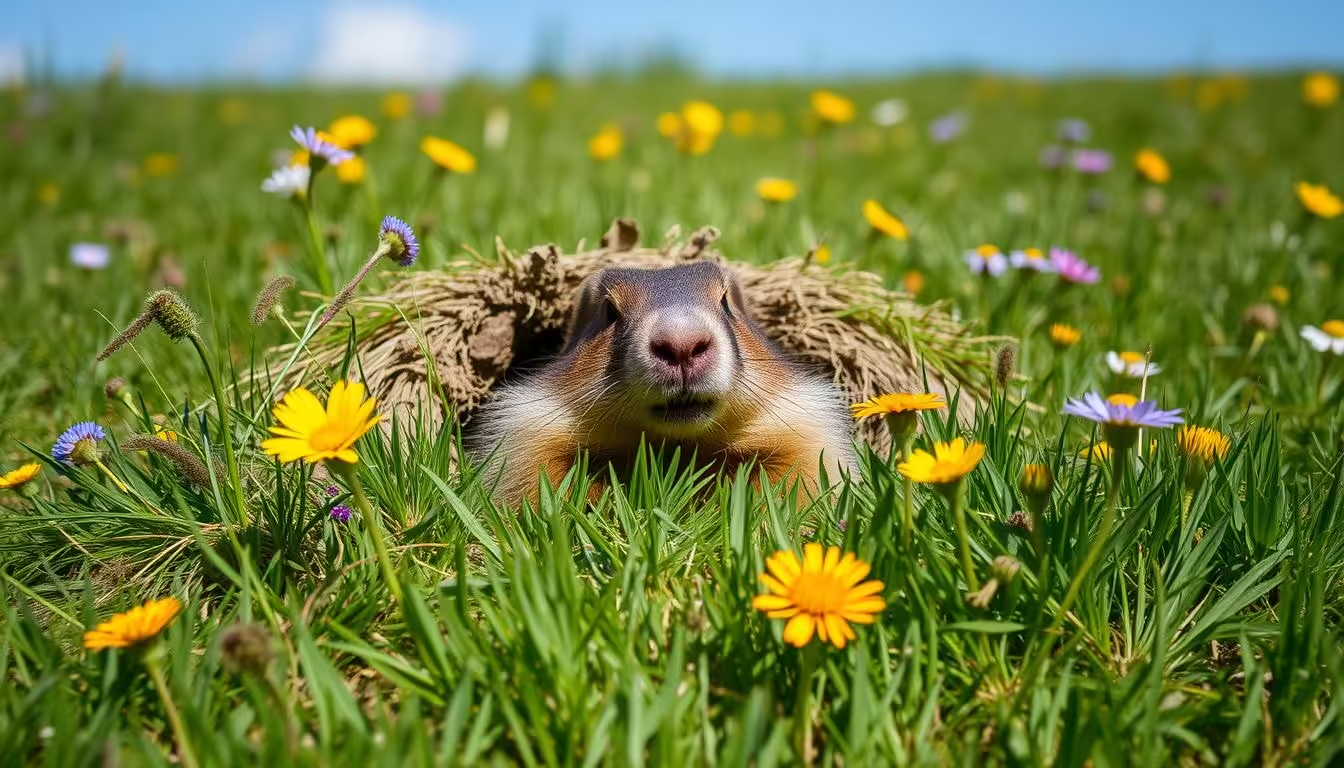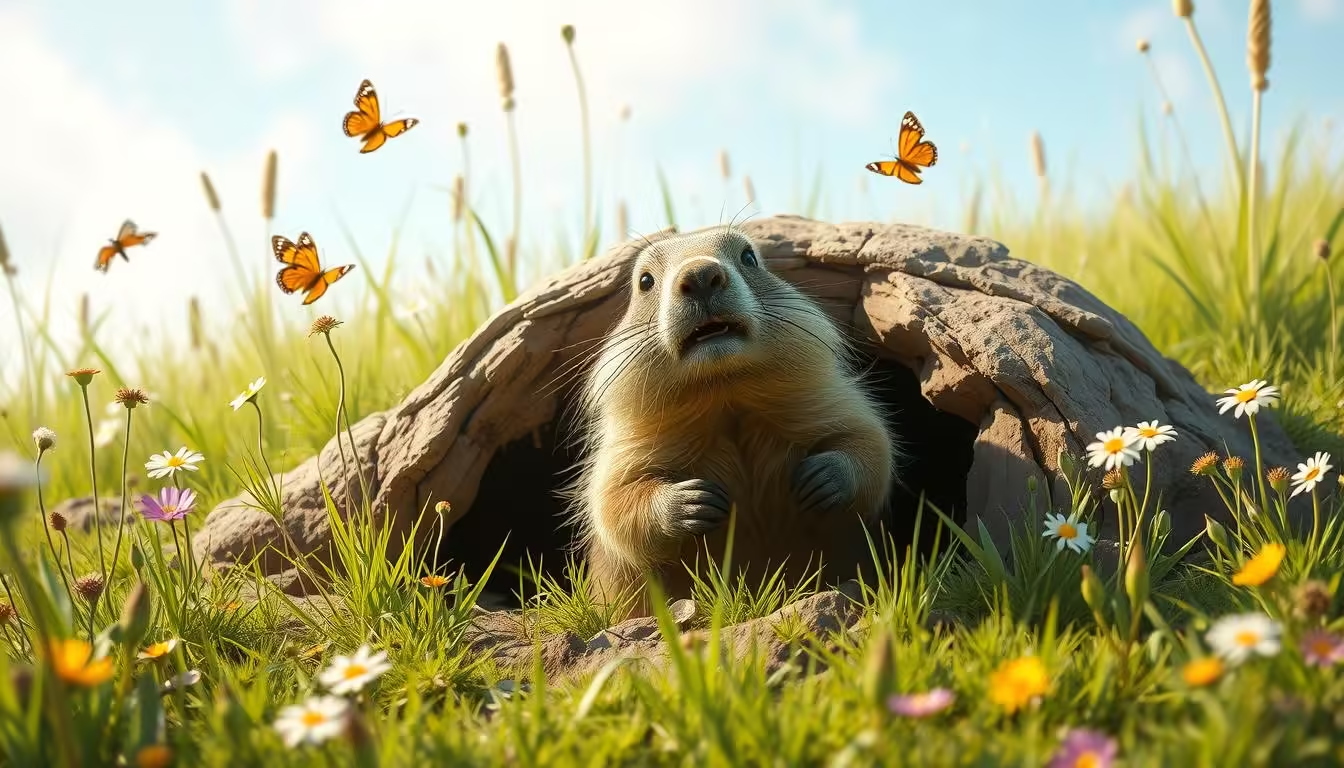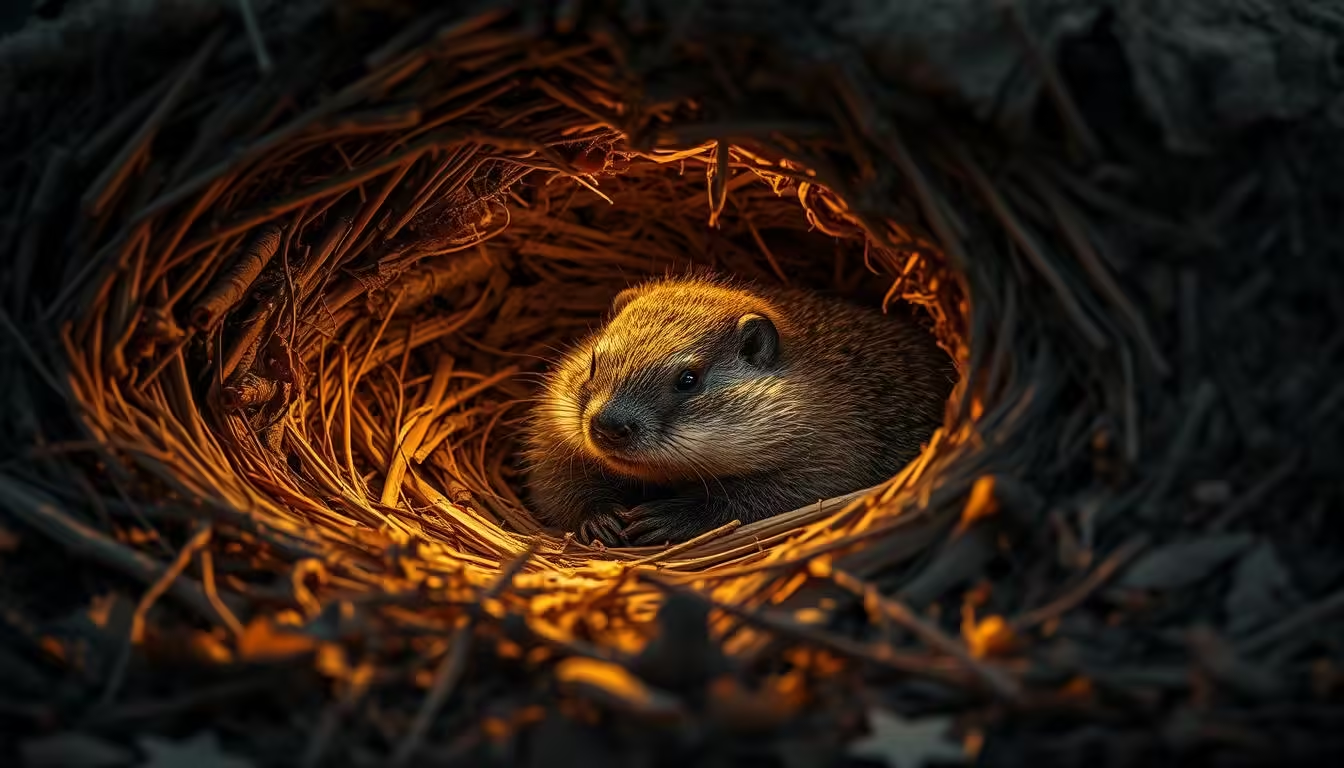Groundhogs, also known as woodchucks, are common in North America. They are not usually aggressive. But, knowing their behavior and health risks is important for living safely together.
These herbivores are active during the day and sleep in burrows during winter. They like living in meadows, pastures, and yards near woods.
Groundhogs might not harm people directly, but they can damage property. They also might carry diseases that can affect pets and people. It’s key to know when they’re around and how to keep them away from homes.
Key Takeaways
- Groundhogs are generally not aggressive but can carry diseases and parasites that pose health risks.
- Understanding groundhog behavior, including their hibernation patterns and burrowing habits, is essential for safe coexistence.
- Groundhogs prefer habitats near fields, pastures, and wooded areas, often creating burrows near building foundations.
- Proactive measures, such as fencing and deterrents, can help prevent groundhog-related property damage.
- Recognizing signs of groundhog activity and knowing when to contact wildlife control professionals can help homeowners manage groundhog presence effectively.
Introduction to Groundhogs and Their Habits
Groundhogs, also known as woodchucks, are large ground squirrels from eastern North America. They have brown coats, small ears, and short tails. They are as big as a house cat and live in open fields and forests.
What Are Groundhogs?
Groundhogs belong to the marmot family, found in North America and Eurasia. They are herbivores, measuring 17.75 to 24 inches long and weighing about 13 pounds. Their tails add 7 to 9.75 inches to their length.
Common Groundhog Habitats
Groundhogs live mainly in eastern North America. They like open fields and meadows near forests. They dig burrows, sometimes near human buildings, with entrances up to 6 feet deep and 20 feet wide.
Groundhog Diet and Feeding Habits
Groundhogs eat green plants like grasses, flowers, and vegetables. In summer, they eat up to 1.5 pounds of food daily. This can make them gain a lot of weight, which can be a problem for gardeners and farmers.
“Groundhogs are herbivorous, feeding on green vegetation, especially agricultural crops and garden vegetables.”
Groundhog Behavior: Understanding Their Nature
Groundhogs, also known as woodchucks, are fascinating creatures. They have complex social structures and unique behaviors. These animals are mostly solitary but come together during mating season.
During mating, they perform intricate courtship rituals. Female groundhogs then give birth to 2-6 pups. The young stay with their mother for a few weeks before becoming independent.
Groundhogs are highly territorial. They spend a lot of time watching their surroundings for threats. They use vocalizations, body postures, and scent markings to communicate and establish dominance.
Groundhog Hibernation
One of the most remarkable aspects of groundhog behavior is their hibernation. They hibernate for 3-6 months, from late October to late February. This is in their deep underground burrows.
Their hibernation is triggered by cold weather and food scarcity. Their metabolism slows down to conserve energy during this time.
During hibernation, groundhogs enter a state of torpor. Their body temperature, heart rate, and breathing rate all decrease. This adaptation helps them survive the harsh winter when food is scarce.
As the weather warms and food becomes more plentiful, they emerge from their burrows. This signals the arrival of spring.
Understanding groundhogs’ social structure, territorial behavior, and hibernation is key. It helps us appreciate these unique creatures and their role in the ecosystem.
Are Groundhogs Aggressive? An In-Depth Look
Groundhogs are not usually aggressive towards humans. They like to run away when scared and hide in their burrows. But, they might get defensive if they think their babies are in danger or if they feel trapped.
Defensive Mechanisms
Groundhogs have ways to defend themselves when scared. They make a high-pitched whistle or a loud chattering sound. This is their warning to stay away. If they’re really scared, they might stand up on their hind legs and spread their front paws to look bigger.
Signs of Aggression
Groundhogs are not usually aggressive, but they can be in some situations. Signs of aggression include showing their teeth, lunging, and trying to bite. This usually happens during mating season or when a mom is protecting her babies. Also, a sick or injured groundhog might act aggressively.
When to Be Cautious
It’s wise to keep a distance from a groundhog, especially if there are babies around or if the groundhog seems upset. Groundhogs can carry diseases like rabies, so any odd behavior should be reported. If a groundhog acts aggressively, stay far away and don’t try to provoke it.
“Groundhogs are generally not aggressive, but they may become defensive if they feel threatened or if their young are in danger.”
Health Risks Associated with Groundhogs
Groundhogs, also known as woodchucks, don’t usually cause big health problems. But, they can carry diseases that worry humans and pets. They might have fleas and ticks, which can spread diseases. Rabies is a big concern with groundhogs.
Common Diseases Transmitted by Groundhogs
Rabies is a serious virus that can spread through bites or scratches from infected groundhogs. Signs include acting confused, falling over, or walking in circles. Groundhogs can also carry salmonellosis, leptospirosis, and parasites like giardiasis and cryptosporidiosis.
Parasites and Their Impacts
Groundhogs can have fleas, ticks, and mites. These can harm humans and pets. They can spread diseases like Lyme disease, Rocky Mountain spotted fever, and ehrlichiosis. Keeping your pets healthy and treating any infestations quickly is key.
Protecting Pets from Groundhogs
To keep your pets safe from groundhogs, make sure their vaccinations are current. Especially for rabies. Keep your pets away from wildlife, including groundhogs. Watch your pets closely if they meet a groundhog. If you’re worried, talk to a vet.
| Health Concern | Potential Risks | Preventive Measures |
|---|---|---|
| Rabies | Serious viral infection transmitted through bites or scratches | Ensure pet vaccinations are up to date, avoid contact with wildlife |
| Parasitic Infections | Diseases like Lyme disease, Rocky Mountain spotted fever, ehrlichiosis | Regular pet check-ups, prompt treatment of infestations |
| Bacterial Infections | Salmonellosis, leptospirosis | Maintain good hygiene, avoid direct contact with groundhogs |
“Groundhogs may be cute, but they can carry diseases that pose a real threat to both humans and pets. It’s crucial to be aware of the potential health risks and take proper precautions to protect ourselves and our furry companions.”
Groundhogs and Property Damage
Groundhogs are loved for Groundhog Day, but they can harm homes. Groundhog infestations and groundhog burrows cause big property damage. This can lead to trouble and money problems for homeowners.
Signs of Groundhog Infestation
Look for big holes in your yard, damaged gardens, and soil mounds. These signs mean a groundhog infestation is happening. They show that groundhogs are digging complex burrows.
How Groundhogs Create Burrows
Groundhogs are great at digging. They make tunnels up to 45 feet long and several feet deep. These burrows can harm buildings, make lawns dangerous, and damage underground lines.
In 2020, over 532,000 utility line damages were reported in the U.S. Many were caused by groundhogs digging.
Preventing Groundhog Damage
- Seal holes around buildings to keep groundhogs out.
- Put up fencing around gardens and other areas, making sure it goes two feet deep.
- Use things like motion-activated sprinklers or noise makers to scare them away.
- Check your property often for signs of groundhog infestation and fix problems quickly.
Preventing groundhog burrows and property damage helps protect your home. Being careful and acting fast is important. This way, you can live with groundhogs without problems.
How to Safely Coexist with Groundhogs
Living peacefully with groundhogs, also known as woodchucks, is doable. To keep them away, use a mix of prevention and deterrents. This approach can help protect your property.
Tips for Securing Your Yard
Putting up a strong fence is a top way to keep groundhogs out. Make sure the fence is buried 12 inches deep and is at least 3 feet tall. This stops them from climbing or digging under it.
Non-Lethal Deterrents
- Use motion-activated devices like sprinklers or lights to scare them off.
- Hang reflective objects like mylar balloons or pinwheels to scare them away.
- Apply natural repellents like castor oil or predator urine around your property.
When to Call Wildlife Control
If your deterrents don’t work and your property gets damaged, call a wildlife control service. They can safely remove the groundhogs and help you prevent future problems. Don’t try to trap them yourself, as it can harm their young.
By using these methods, you can safely live with groundhogs. This way, you protect your property and respect the natural world.
Groundhog Myths vs. Facts
Groundhogs have many myths and misconceptions in popular culture. The Groundhog Day celebration made them famous. It’s important to know the truth about their behavior and biology.
Common Misconceptions
One big myth is that groundhogs can predict the weather. They don’t have special powers to forecast spring. Their shadow on Groundhog Day is just part of their hibernation cycle.
Another myth is that groundhogs can’t climb or swim. But they are great climbers and swimmers. They easily move through their burrows.
The Truth About Groundhog Behavior
Groundhogs, or woodchucks, are big squirrels. They are not moles or gophers. They dig big burrows with many entrances and rooms.
They don’t whistle to predict the weather. They whistle to warn others of danger. Their hibernation is based on temperature and daylight, not magic.
Groundhogs in Popular Culture
Punxsutawney Phil is the most famous groundhog. He’s the star of Groundhog Day in Pennsylvania. This event started with old festivals and now draws thousands of visitors.
Groundhog Day is fun but not scientifically accurate. Groundhogs are complex animals. We should respect and understand them.
Groundhogs in the Ecosystem
Groundhogs, also known as woodchucks, are key to their ecosystems. They help keep their habitats healthy and diverse.
The Role of Groundhogs in Their Habitat
Groundhogs are vital to their environment. Their digging helps the soil and gives homes to many animals. This supports a wide range of plants and animals.
Groundhogs as Prey for Predators
Groundhogs are a main food source for many animals. Predators like foxes, coyotes, hawks, and owls count on them. This is especially true in spring and summer when groundhogs are most active.
Importance of Biodiversity
Groundhogs show the health of an ecosystem. They live well with other species, helping the ecosystem balance. Keeping groundhogs around supports many plants and animals.
| Groundhog Ecosystem Role | Groundhog Predators | Biodiversity Indicators |
|---|---|---|
| Aerate soil, provide shelter for other animals | Foxes, coyotes, hawks, owls | Diverse plant and animal species |
| Support growth of diverse plant life | Rely on groundhogs as a food source | Healthy balance of predator-prey relationships |
| Considered a keystone species | Most active in spring and summer | Indicator of ecological equilibrium |
“The presence of groundhogs in an ecosystem is a testament to the overall biodiversity of the region.”
Understanding Groundhog Seasonality
Groundhog behavior changes with the seasons. These rodents show different patterns of activity and hibernation. These patterns are linked to temperature and daylight changes.
Groundhog Day: Tradition vs. Reality
Groundhog Day on February 2nd is a big tradition. It’s believed that a groundhog’s emergence can predict spring. But, in reality, a groundhog’s emergence is more about temperature than weather forecasting.
Seasonal Behavior Changes
Groundhogs hibernate from late fall to early spring. They sleep deeply as temperatures fall. After waking up, they mate and have 2-4 kits.
They are most active in spring and summer. During this time, they forage, build burrows, and get ready for hibernation.
Impact of Seasons on Groundhog Activity
Groundhog activity changes with the seasons. In spring and summer, they are seen above ground. They look for food and keep their burrows in order.
As autumn comes, they eat more. They build up fat reserves for winter hibernation.
| Season | Groundhog Activity |
|---|---|
| Spring | Emerge from hibernation, mate, give birth to kits |
| Summer | Foraging, burrowing, and preparing for hibernation |
| Fall | Increase food intake, add fat reserves for hibernation |
| Winter | Hibernate, body temperature and heart rate slow down |
By knowing about Groundhog Day, groundhog seasonal behavior, and groundhog hibernation, we can appreciate these creatures more. We see their natural rhythms and adaptations.
How to Handle Groundhog Encounters
Seeing a groundhog in the wild can be thrilling but also delicate. These animals are common in many parts of the United States. It’s key to know how to safely watch and interact with them. By following a few simple rules, you can enjoy watching groundhogs while keeping them and yourself safe.
What to Do if You See a Groundhog
If you spot a groundhog, keep a safe distance and don’t make sudden moves. Groundhogs can get scared easily and might see sudden actions as threats. Watch the animal from afar, using binoculars or a zoom lens if you need to. Don’t try to approach, touch, or feed the groundhog. This can be risky for both you and the animal.
Safe Ways to Observe Groundhogs
- Use binoculars or zoom lenses to watch groundhogs from a safe distance.
- Remain calm and avoid making loud noises or sudden movements.
- Respect the animal’s personal space and do not attempt to interact with it directly.
- Observe groundhogs during their active periods, typically in the early morning and afternoon.
Educating Children About Groundhogs
Groundhog encounters are a great chance to teach kids about wildlife and peaceful coexistence. Teach them to admire groundhogs from a distance and explain why it’s important not to disturb them. Talk about the groundhog’s role in the ecosystem and the need to respect their natural behaviors and habitats.
If a groundhog looks sick or injured, call local wildlife authorities for help. By learning how to handle groundhog encounters safely and responsibly, we can grow to appreciate these amazing creatures. This helps promote the well-being of wildlife in our communities.
Conclusion: Embracing Groundhogs in Our Lives
Groundhogs are vital to our ecosystems. They might seem like pests, but knowing their habits helps us live together safely. By respecting their space and taking care, we can avoid risks and protect both us and them.
Summary of Key Points
We’ve looked at groundhog behavior, their social lives, and health risks. We’ve also talked about their role in nature and debunked myths about weather prediction. This knowledge helps us understand and appreciate them more.
Encouraging Respect for Wildlife
Learning about groundhogs and other wildlife helps us protect nature. By teaching others about their importance, we can live in better harmony with the environment. Respecting their space and using humane ways to keep them away ensures a peaceful coexistence.
Final Thoughts on Groundhog Safety
Remember, groundhogs are not usually aggressive but can be if upset. By being careful and keeping our distance, we can enjoy their company. This way, we prioritize their well-being and ours.



